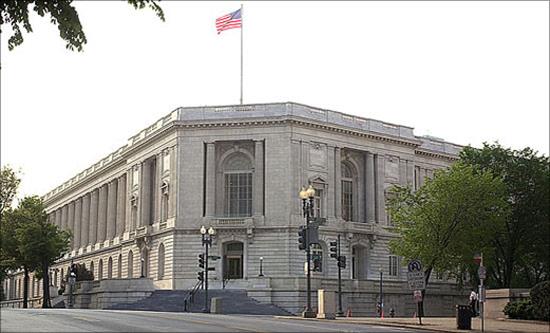
The Cannon House Office Building
The Committee offices are located in the Cannon House Office Building, the oldest congressional office building as well as a significant example of the Beaux Arts style of architecture (1905). Until 1908, many representatives who wanted office space had to rent quarters or borrow space in committee rooms in the Capitol. The Sundry Civil Appropriation Act (3 Stat 1156) of March 1901 authorized the Architect of the Capitol to draw plans for a fireproof building adjacent to the grounds of the Capitol Building to be used for offices and storage. On March 3, 1903, a similar appropriation authorized acquisition of a site and construction of the building. The House Office Building Commission, composed of three representatives appointed by the Speaker of the House, was established to supervise construction. Appointed were Representatives Joseph G. Cannon, William P. Hepburn and James D. Richardson. Subject to the approval of the commission, Architect of the Capitol Elliott Woods was responsible for the letting of contracts and construction of the building.
The Commission retained the service of the prominent New York architectural firm of Carrere and Hastings. One partner, Thomas Hastings, took charge of the House Office Building project, while John Carrere oversaw the construction of a similar office building for the Senate. The firm had helped redesign the Library of Congress space vacated 1897 on the second and third floors of the Capitol, and therefore had a well-established working relationship with the Architect of the Capitol.
Carrere and Hastings looked upon the House and Senate Office Buildings as restrained complements to the more important Capitol. The designs were suitably rich, yet subtle, to provide an appropriate backdrop for the Capitol. The office buildings were not intended to compete architecturally with the Library of Congress.
The exterior of the House Office Building is classical, clearly reminiscent of the Colonnade du Louvre in Paris. Architecturally, the elevation is divided into two parts: a rusticated base that supports a colonnade with an entablature and balustrade. The colonnade with thirty-four Doric columns on Independence Avenue is echoed by pilasters on the New Jersey Avenue facade.
Construction of the building was complicated by the Washington Terminal Company which had been granted an easement for construction of a twin railway tunnel for the Pennsylvania Railroad Company under the southeast corner of the building site. In order to support the building with much of its foundations underpinned by this tunnel, engineers had to drive concrete pilings 26 feet deep.
The building was designed in the form of a hollow square to admit light to inner offices. On each floor the offices were on both sides of a 12-foot wide corridor. There were 397 offices, one office for each representative of the 61st Congress. In addition there were fourteen committee rooms. A modern building for its time, it boasted such facilities as a forced air ventilation system, steam heat, individual lavatories with hot and cold running water and ice water, telephones and electricity on many circuits.
Of special architectural interest on the interior of the Cannon Building is the Rotunda. Located at the main entrance of the building, it has a diameter of 57 feet, 4 inches. Eighteen Corinthian columns on a marble arcade support a richly detailed entablature and coffered dome. The oculus of the dome is glazed to flood the Rotunda with natural light. At the rear of the Rotunda twin marble staircases lead to the imposing Caucus Room. Noteworthy architectural features of the room are the giant order Corinthian pilasters, a full entablature and the richly detailed ceiling ornamented with various classical motifs. In these public spaces Carrere and Hastings provided the House Office Building with some of the most important and handsome interiors of the early 20th century.
The building was occupied by the 60th Congress on December 12, 1907. The House, by resolution, directed the Speaker to appoint a select committee of five members to arrange for distribution of rooms.
By 1913 the House had outgrown the office space. Fifty-one rooms were added to the original structure by raising the roof and constructing a fifth floor.
With the growing need for space, it was decided in 1924 to construct another building (the Longworth), and to renovate the old one. This remodeling, completed between August and November of 1932, resulted in 171 two-room suites, fourteen three-room suites, ten single rooms and twenty-three committee rooms. Other improvements to the Cannon Building included:
- 1933-1938: Elevators replaced
- 1933-1938: Air conditioning installed
- 1955: 308 car garage constructed in the courtyard
- 1966: Remodeled to reconfigure the suites
On May 21, 1962, Public Law 87-453 was passed to rename the three House of Representatives office buildings, which had been referred to simply as the "Old", "New", and "Additional". The "New" House Office Building was named for Representatives Joseph Gurney Cannon who had served as Speaker of the House of Representatives (1925-1931) when the building was authorized.
Architectural Division for Office of the Curator
April 1988